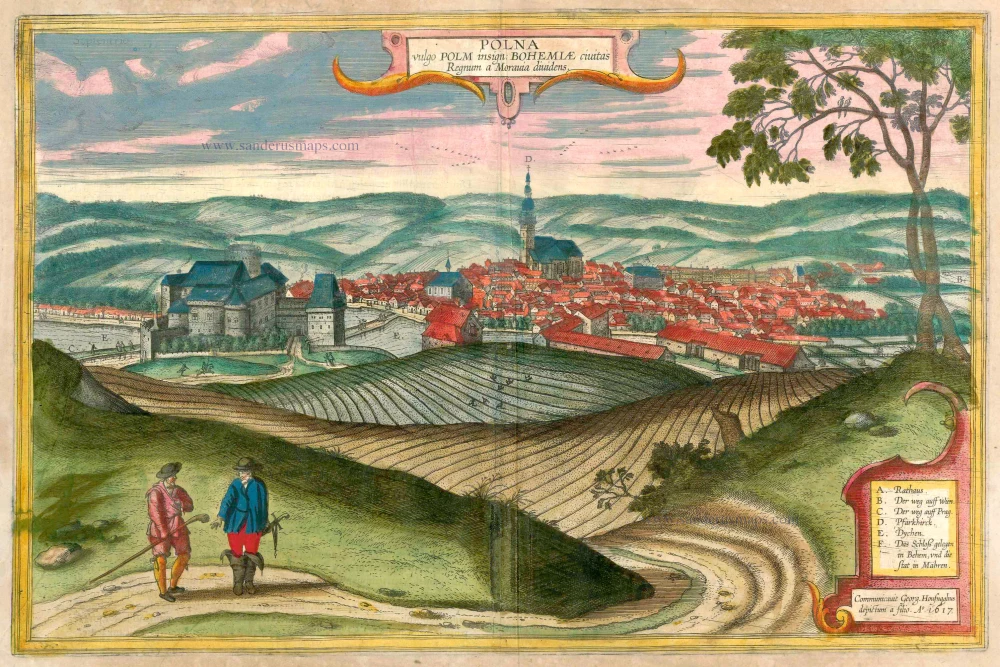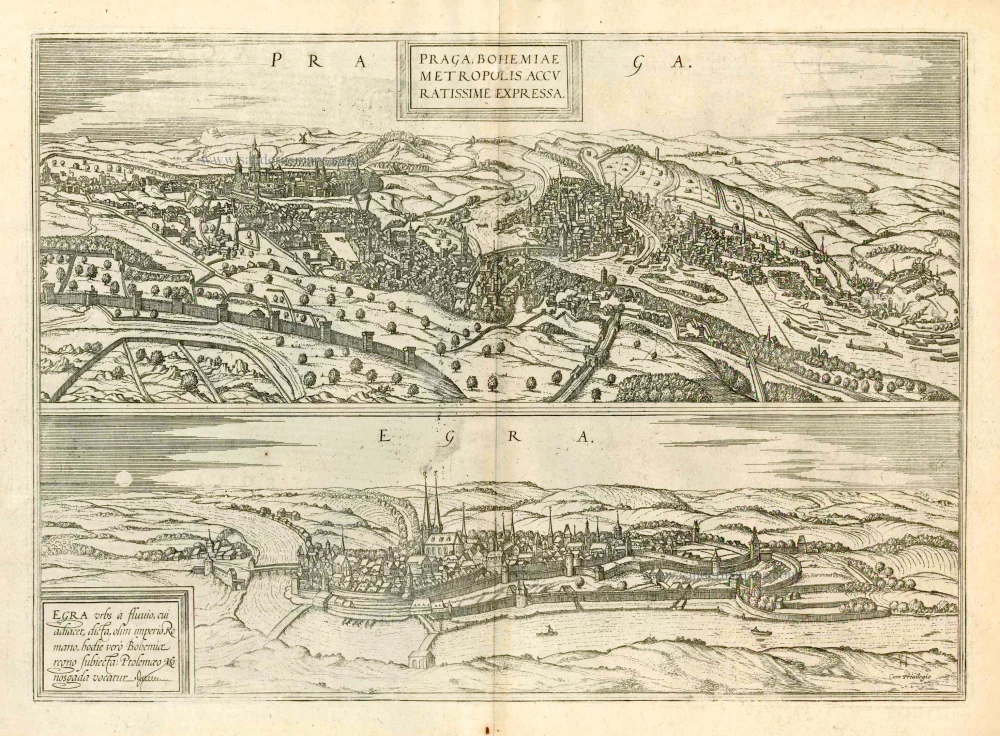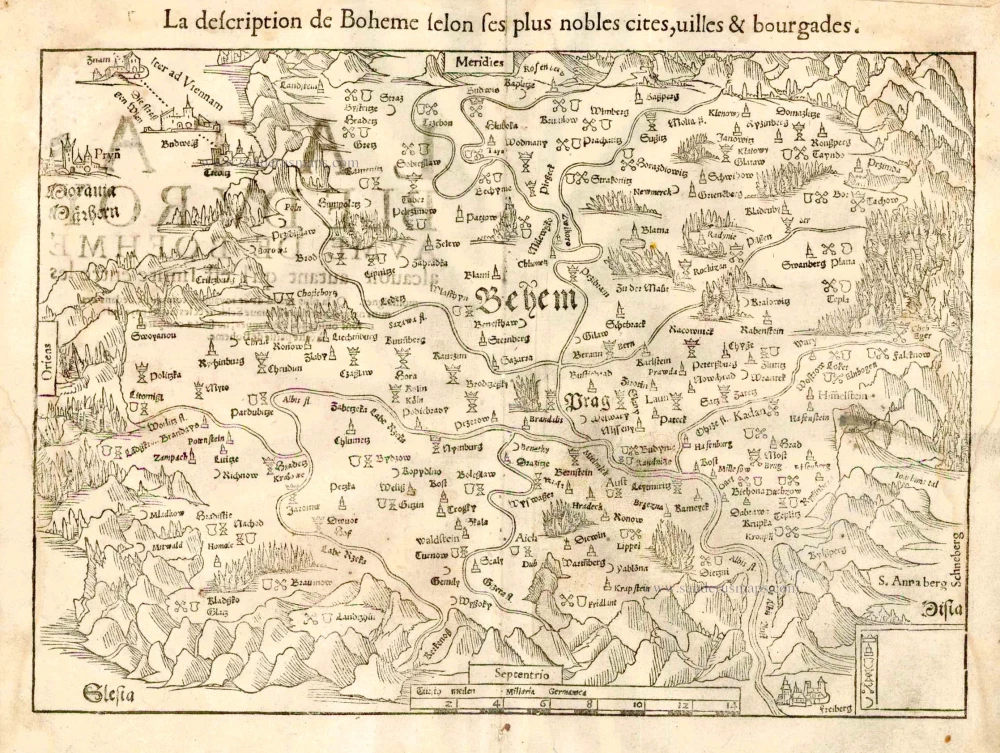Bohemia - Caslav (Tschaslau) and Chomutov, by Georg Braun and Frans Hogenberg. c. 1625
CASLAV
CAPTION: Czalavium, in the vernacular Caslav, town in Bohemia.
TRANSLATION OF CARTOUCHE TEXT: Inscription on the tomb of Jan Zizka: Jan Zizka of the Chalice, director of public affairs, died in the year 1424, on the Tuesday before the festival of St Gallus. He was burried in the name of God in this chapel.
COMMENTARY BY BRAUN (on verso): "But Caslav is so famous today because the extraordinary Hussite warrior, blind Zizka, is buried here. [...] After the Hussites had arisen in Bohemia and wilfully ravaged the kingdom, he joined them and gathered around him a crowd of the lowest rabble and other shade characters, with whom he attacked the remaining churches and destroyed the images; and they also plundered the Carthusian monastery in Prague and set it on fire." This town, which was founded in the 13th century, is shown from the south from a relatively great distance, with the church of SS Peter and Paul as its dominating feature. This church forms a mental link to the main motif, the sarophagus (right foreground) of the Hussite general Jan Zizka, who is depicted on the left. Among other things, he several times defeated the Catholic King Sigismund through his use of battle wagons. Zizka's burial in Caslav was a symbolic act, for it was here that Emperor Sigismund had been deposed as king of Bohemia in 1421, after failing to prevent the Reformer Jan Hus being burned at the stake in Constance in 1415, despite the fact that he had issued a writ of protection for him.
CHOMUTOV
CARTOUCHE TOP LEFT: Commoda, in the vernacular Chomutov, a city in Bohemia.
CARTOUCHE RIGHT: Procured by Georg Hoefnagel, painted by his son, in the year 1617.
COMMENTARY BY BRAUN (on verso): "This is a fine city, in respect of its surroundings and position and also in respect of its buildings and fine adornments. But we can say of it only so much, that Zizka, after achieving nothing in Pilsen, came to this city and captured it by force. He then ravaged it, locking many of the burghers together with the priests and clerics in wooden buildings, and despite their pleas for mercy, set them on fire. [...] Today the Jesuits have a fine seminary and a school there, where young people are instructed very diligently both in the ways of God and in the liberal arts." This is a view of the city from a considerable distance, looking towards the south from the southern slopes of the Erzgebirge Mountains. A small chapel can be seen in the right foreground on the trade route (A) to Leipzig. The north Bohemian city is dominated by the high town hall tower (E), with the castle (D) to the right of it. To the left of the town hall is the late Gothic parish church of the Assumption of the Blessed Virgin (F). In the mid-13th century the town passed into the possession of the Teutonic Knights, which made it attractive to many German settlers. The Teutonic Knights were driven out by the Hussites in 1421, and in the 16th century the town passed to the powerful Lobkovic family, who built a Renaissance palace here around 1520.
Braun G. & Hogenberg F. and the Civitates Orbis Terrarum.
The Civitates Orbis Terrarum, also known as the 'Braun & Hogenberg', is a six-volume town atlas and the most excellent book of town views and plans ever published: 363 engravings, sometimes beautifully coloured. It was one of the best-selling works in the last quarter of the 16th century. Georg Braun, a skilled writer, wrote the text accompanying the plans and views on the verso. Many plates were engraved after the original drawings of a professional artist, Joris Hoefnagel (1542-1600). The first volume was published in Latin in 1572 and the sixth in 1617. Frans Hogenberg, a talented engraver, created the tables for volumes I through IV, and Simon van den Neuwel made those for volumes V and VI. Other contributors were cartographers Daniel Freese and Heinrich Rantzau, who provided valuable geographical information. Works by Jacob van Deventer, Sebastian Münster, and Johannes Stumpf were also used as references. Translations appeared in German and French, making the atlas accessible to a wider audience.
Since its original publication of volume 1 in 1572, the Civitates Orbis Terrarum has left an indelible mark on the history of cartography. The first volume was followed by seven more editions in 1575, 1577, 1582, 1588, 1593, 1599, and 1612. Vol.2, initially released in 1575, saw subsequent editions in 1597 and 1612. The subsequent volumes, each a treasure trove of historical insights, graced the world in 1581, 1588, 1593, 1599, and 1606. The German translation of the first volume, a testament to its widespread appeal, debuted in 1574, followed by the French edition in 1575.
Several printers were involved: Theodor Graminaeus, Heinrich von Aich, Gottfried von Kempen, Johannis Sinniger, Bertram Buchholtz, and Peter von Brachel, all of whom worked in Cologne.
Georg Braun (1541-1622)
Georg Braun, the author of the text accompanying the plans and views in the Civitates Orbis Terrarum, was born in Cologne in 1541. After his studies in Cologne, he entered the Jesuit Order as a novice, indicating his commitment to learning and intellectual pursuits. In 1561, he obtained his bachelor's degree; in 1562, he received his Magister Artium, further demonstrating his academic achievements. Although he left the Jesuit Order, he continued his studies in theology, gaining a licentiate in theology. His theological background likely influenced the content and tone of the text in the Civitates Orbis Terrarum, adding a unique perspective to the work.
Frans Hogenberg (1535-1590)
Frans Hogenberg was a Flemish and German painter, engraver, and mapmaker. He was born in Mechelen as the son of Nicolaas Hogenberg.
By the end of the 1560s, Frans Hogenberg was employed upon Abraham Ortelius's Theatrum Orbis Terrarum, published in 1570; he is named an engraver of numerous maps. In 1568, he was banned from Antwerp by the Duke of Alva and travelled to London, where he stayed a few years before emigrating to Cologne. He immediately embarked on his two most important works, the Civitates, published in 1572 and the Geschichtsblätter, which appeared in several series from 1569 until about 1587.
Thanks to large-scale projects like the Geschichtsblätter and the Civitates, Hogenberg's social circumstances improved with each passing year. He died as a wealthy man in Cologne in 1590.
Czaslavium vulgo Czasla Bohemiae Civitas [on sheet with] Commoda vulgo Comethau Bohemiae Civitas.
Item Number: 16421 Authenticity Guarantee
Category: Antique maps > Europe > Central Europe
Antique map with two bird's-eye views by Braun and Hogenberg: Caslav (Tschaslau) and Chomutov in Bohemia.
Title: Czaslavium vulgo Czasla Bohemiae Civitas [on sheet with] Commoda vulgo Comethau Bohemiae Civitas.
Drawn by G. Hoefnagel and son, 1617.
Key to six locations.
Date of the first edition: 1617
Date of this map: c. 1625
Copper engraving, printed on paper.
Size (not including margins): 37 x 47cm (14.4 x 18.3 inches)
Verso text: French
Condition: Original coloured, excellent.
Condition Rating: A+
References: Van der Krogt 4, 813; Taschen, Br. Hog., p.462; Fauser, #2384 #6803.
From: Théatre des Principales Villes de tout l'Univers Vol. VI. c. 1625. (Van der Krogt 4, 41:3.6)
CASLAV
CAPTION: Czalavium, in the vernacular Caslav, town in Bohemia.
TRANSLATION OF CARTOUCHE TEXT: Inscription on the tomb of Jan Zizka: Jan Zizka of the Chalice, director of public affairs, died in the year 1424, on the Tuesday before the festival of St Gallus. He was burried in the name of God in this chapel.
COMMENTARY BY BRAUN (on verso): "But Caslav is so famous today because the extraordinary Hussite warrior, blind Zizka, is buried here. [...] After the Hussites had arisen in Bohemia and wilfully ravaged the kingdom, he joined them and gathered around him a crowd of the lowest rabble and other shade characters, with whom he attacked the remaining churches and destroyed the images; and they also plundered the Carthusian monastery in Prague and set it on fire." This town, which was founded in the 13th century, is shown from the south from a relatively great distance, with the church of SS Peter and Paul as its dominating feature. This church forms a mental link to the main motif, the sarophagus (right foreground) of the Hussite general Jan Zizka, who is depicted on the left. Among other things, he several times defeated the Catholic King Sigismund through his use of battle wagons. Zizka's burial in Caslav was a symbolic act, for it was here that Emperor Sigismund had been deposed as king of Bohemia in 1421, after failing to prevent the Reformer Jan Hus being burned at the stake in Constance in 1415, despite the fact that he had issued a writ of protection for him.
CHOMUTOV
CARTOUCHE TOP LEFT: Commoda, in the vernacular Chomutov, a city in Bohemia.
CARTOUCHE RIGHT: Procured by Georg Hoefnagel, painted by his son, in the year 1617.
COMMENTARY BY BRAUN (on verso): "This is a fine city, in respect of its surroundings and position and also in respect of its buildings and fine adornments. But we can say of it only so much, that Zizka, after achieving nothing in Pilsen, came to this city and captured it by force. He then ravaged it, locking many of the burghers together with the priests and clerics in wooden buildings, and despite their pleas for mercy, set them on fire. [...] Today the Jesuits have a fine seminary and a school there, where young people are instructed very diligently both in the ways of God and in the liberal arts." This is a view of the city from a considerable distance, looking towards the south from the southern slopes of the Erzgebirge Mountains. A small chapel can be seen in the right foreground on the trade route (A) to Leipzig. The north Bohemian city is dominated by the high town hall tower (E), with the castle (D) to the right of it. To the left of the town hall is the late Gothic parish church of the Assumption of the Blessed Virgin (F). In the mid-13th century the town passed into the possession of the Teutonic Knights, which made it attractive to many German settlers. The Teutonic Knights were driven out by the Hussites in 1421, and in the 16th century the town passed to the powerful Lobkovic family, who built a Renaissance palace here around 1520.
Braun G. & Hogenberg F. and the Civitates Orbis Terrarum.
The Civitates Orbis Terrarum, also known as the 'Braun & Hogenberg', is a six-volume town atlas and the most excellent book of town views and plans ever published: 363 engravings, sometimes beautifully coloured. It was one of the best-selling works in the last quarter of the 16th century. Georg Braun, a skilled writer, wrote the text accompanying the plans and views on the verso. Many plates were engraved after the original drawings of a professional artist, Joris Hoefnagel (1542-1600). The first volume was published in Latin in 1572 and the sixth in 1617. Frans Hogenberg, a talented engraver, created the tables for volumes I through IV, and Simon van den Neuwel made those for volumes V and VI. Other contributors were cartographers Daniel Freese and Heinrich Rantzau, who provided valuable geographical information. Works by Jacob van Deventer, Sebastian Münster, and Johannes Stumpf were also used as references. Translations appeared in German and French, making the atlas accessible to a wider audience.
Since its original publication of volume 1 in 1572, the Civitates Orbis Terrarum has left an indelible mark on the history of cartography. The first volume was followed by seven more editions in 1575, 1577, 1582, 1588, 1593, 1599, and 1612. Vol.2, initially released in 1575, saw subsequent editions in 1597 and 1612. The subsequent volumes, each a treasure trove of historical insights, graced the world in 1581, 1588, 1593, 1599, and 1606. The German translation of the first volume, a testament to its widespread appeal, debuted in 1574, followed by the French edition in 1575.
Several printers were involved: Theodor Graminaeus, Heinrich von Aich, Gottfried von Kempen, Johannis Sinniger, Bertram Buchholtz, and Peter von Brachel, all of whom worked in Cologne.
Georg Braun (1541-1622)
Georg Braun, the author of the text accompanying the plans and views in the Civitates Orbis Terrarum, was born in Cologne in 1541. After his studies in Cologne, he entered the Jesuit Order as a novice, indicating his commitment to learning and intellectual pursuits. In 1561, he obtained his bachelor's degree; in 1562, he received his Magister Artium, further demonstrating his academic achievements. Although he left the Jesuit Order, he continued his studies in theology, gaining a licentiate in theology. His theological background likely influenced the content and tone of the text in the Civitates Orbis Terrarum, adding a unique perspective to the work.
Frans Hogenberg (1535-1590)
Frans Hogenberg was a Flemish and German painter, engraver, and mapmaker. He was born in Mechelen as the son of Nicolaas Hogenberg.
By the end of the 1560s, Frans Hogenberg was employed upon Abraham Ortelius's Theatrum Orbis Terrarum, published in 1570; he is named an engraver of numerous maps. In 1568, he was banned from Antwerp by the Duke of Alva and travelled to London, where he stayed a few years before emigrating to Cologne. He immediately embarked on his two most important works, the Civitates, published in 1572 and the Geschichtsblätter, which appeared in several series from 1569 until about 1587.
Thanks to large-scale projects like the Geschichtsblätter and the Civitates, Hogenberg's social circumstances improved with each passing year. He died as a wealthy man in Cologne in 1590.












